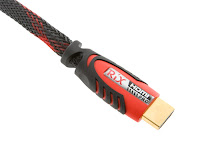The jargon used by these companies can be overwhelming, battering potential customers into making a purchase with sheer complexity. Here's a couple of typical quote from Monster cable, arguably the most prominent of these companies:
"Take 1080p video with advanced 12-bit color, also called Deep Color, available right now from the PlayStation® 3. To experience this level of high definition performance, your HDMI cable must exceed the requirements of the HDMI 1.3a, CAT 1 specification, and support an astonishing cable data rate of 6.68 Gbps. That's more than six billion bits per second, six times the data rate required for standard DVD playback. That speed is also higher than what's required for Simplay HD verification. In other words, just because a cable is Simplay HD logo on the packaging, doesn't necessarily mean it supports Deep Color."

"To get all the performance you paid for, you need to buy a true high performance cable that's fully compliant with the most current HDMI standards, and preferably one that exceeds today's standards, so you don't have to upgrade your cable when you add or upgrade HD components in the future" - Monster Website
Unfortunately Choice magazine don't agree, they have compared several cheap and big brand digital cables and they made almost no difference. Here's the article, and the bottom line is:
"Our testing found no statistically significant variations in score either for picture or sound. Although the results were slightly in favour of the more expensive brand for longer lengths, the differences were not enough to conclude any brand delivers a significantly better result.
Results for the digital audio cable were even more conclusive, with no advantage to be gained through the use of more expensive cables for better performance."
This isn't the only report with the same conclusion - CNET, CBC and the Consumerist all agree.
One thing to note, when they say there is a slight favour for more expensive brands on longer cables, they are talking 33 meters - if you're putting your TV that far from your equipment then by all means buy expensive cables. Not all HDMI cables are created equal, but they will nearly all work perfectly in the average 2 or 3 metres needed for a standard home theatre set-up - even dirt cheap own brand. If for some reason you crave more detail on this, check out this article here.
The next time you or someone you know is looking for a new TV or replacement cable, steer clear of these expensive brands. Get a sturdy but reasonably priced lead, and used the money saved for something more important.
- Gavin Schofield
This subject is a bit of a tangent from the usual skeptical fare you'd see on blog's like this one, but I'm posting it anyway. It's a subject I know reasonably well, and this has bugged me for quite a while. What I have to say is probably quite widely known, but I hope I can save some money for at least one person!
In this post I'm talking only about digital cables, analogue cables are a little more complicated - but any well made, reasonably cheap cable should do the job fine, you don't need Monster or Profigold. We'll resume the usual ghosts / aliens / alt-med posts shortly.

No comments:
Post a Comment